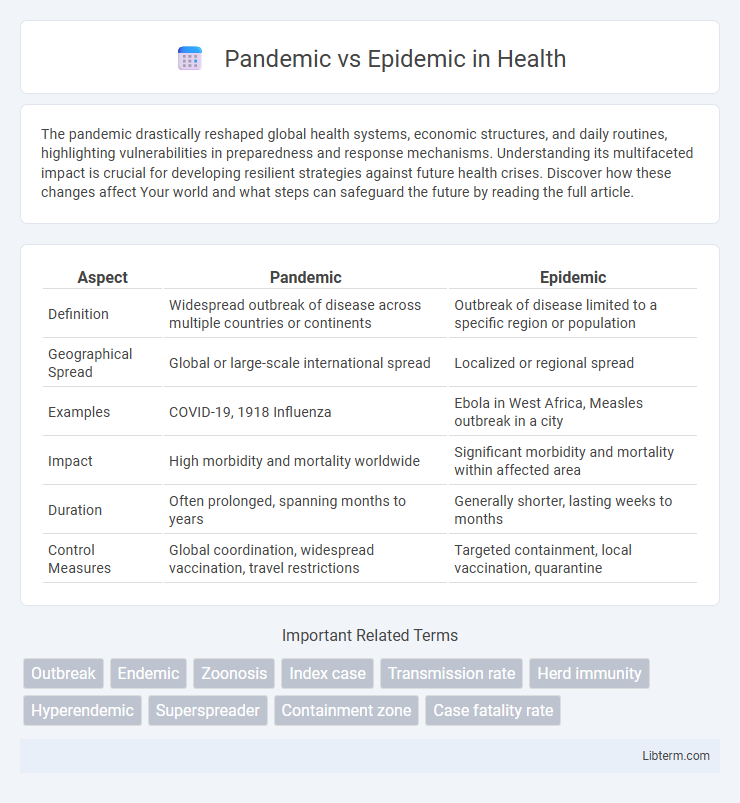The pandemic drastically reshaped global health systems, economic structures, and daily routines, highlighting vulnerabilities in preparedness and response mechanisms. Understanding its multifaceted impact is crucial for developing resilient strategies against future health crises. Discover how these changes affect Your world and what steps can safeguard the future by reading the full article.
Table of Comparison
| Aspect | Pandemic | Epidemic |
|---|---|---|
| Definition | Widespread outbreak of disease across multiple countries or continents | Outbreak of disease limited to a specific region or population |
| Geographical Spread | Global or large-scale international spread | Localized or regional spread |
| Examples | COVID-19, 1918 Influenza | Ebola in West Africa, Measles outbreak in a city |
| Impact | High morbidity and mortality worldwide | Significant morbidity and mortality within affected area |
| Duration | Often prolonged, spanning months to years | Generally shorter, lasting weeks to months |
| Control Measures | Global coordination, widespread vaccination, travel restrictions | Targeted containment, local vaccination, quarantine |
Defining Pandemic and Epidemic
A pandemic refers to an outbreak of a disease that occurs over a wide geographic area, often worldwide, affecting a large proportion of the population. An epidemic is the rapid spread of an infectious disease within a specific community, region, or population, exceeding normal expectancy. Both terms describe disease spread, but pandemics signify a broader, global impact compared to localized epidemics.
Key Differences Between Pandemic and Epidemic
An epidemic refers to a sudden increase in cases of a disease within a specific geographic area or population, whereas a pandemic involves a widespread outbreak across multiple countries or continents affecting a large proportion of the global population. Epidemics are typically localized and contained, while pandemics exhibit sustained person-to-person transmission on a global scale. The World Health Organization (WHO) categorizes pandemics based on their extensive geographical spread and significant impact on health systems worldwide.
Causes of Epidemics and Pandemics
Epidemics and pandemics arise from factors such as zoonotic spillover, genetic mutations in pathogens, and increased human-to-human transmission facilitated by dense populations and global travel. Poor sanitation, lack of vaccination, and environmental changes also contribute to the emergence and rapid spread of infectious agents like viruses and bacteria. Understanding these causes is crucial for developing prevention strategies targeting diseases such as influenza, Ebola, and COVID-19.
Global Impact of Pandemics
Pandemics cause widespread health crises by affecting multiple countries and continents simultaneously, leading to significant economic disruptions, increased mortality rates, and strained healthcare systems worldwide. Unlike epidemics, which are typically confined to specific regions, pandemics demand coordinated global responses to control transmission and mitigate impacts. The COVID-19 pandemic exemplifies the profound social and economic consequences, including global supply chain interruptions and increased unemployment rates.
Localized Effects of Epidemics
Epidemics are outbreaks of diseases that rapidly spread within a specific region or community, causing localized health crises, strain on medical facilities, and disruption of daily life. The impact of epidemics is confined to defined geographic areas, enabling targeted public health interventions such as quarantine, vaccination campaigns, and localized treatment protocols. Understanding the localized effects helps in resource allocation and containment strategies to prevent escalation into pandemics.
Historical Examples: Epidemic vs Pandemic
The Black Death in the 14th century exemplifies a devastating epidemic, rapidly spreading across Europe and killing millions within a localized region. In contrast, the 1918 Spanish Flu represents a pandemic, affecting populations worldwide with an estimated 50 million deaths globally. These historical examples highlight the key difference: epidemics are intense outbreaks confined to specific areas, while pandemics span multiple continents with widespread impact.
Disease Transmission Patterns
Epidemics involve a rapid increase in disease cases within a specific geographic area or population over a short period, often linked to localized transmission patterns. Pandemics, in contrast, refer to the widespread transmission of a disease across multiple countries or continents, affecting a significantly larger population globally. Understanding differences in transmission patterns helps public health officials tailor containment strategies, such as localized interventions for epidemics versus coordinated international response efforts for pandemics.
Prevention and Control Strategies
Prevention and control strategies for pandemics prioritize widespread vaccination, global surveillance, and coordinated public health responses to rapidly contain disease transmission. Epidemic control focuses on localized measures such as targeted quarantine, contact tracing, and outbreak investigation to limit spread within specific communities. Effective implementation relies on timely diagnostic testing, public education, and resource allocation tailored to the scale of the health threat.
Role of Public Health Organizations
Public health organizations play a crucial role in identifying, controlling, and preventing both pandemics and epidemics through surveillance, vaccination campaigns, and public education. They coordinate response efforts by mobilizing resources, implementing quarantine measures, and disseminating accurate information to reduce disease transmission and protect populations. Collaboration with international bodies like the World Health Organization enhances global preparedness and accelerates the development of effective interventions during widespread outbreaks.
Lessons Learned for Future Outbreaks
Effective surveillance and rapid response mechanisms established during epidemics have proven crucial for managing pandemic threats. Strengthening global communication networks and data sharing accelerates containment efforts and resource allocation in outbreak scenarios. Emphasizing early detection, vaccination strategies, and public health infrastructure resilience enhances preparedness for future pandemics and limits widespread transmission.
Pandemic Infographic

 libterm.com
libterm.com